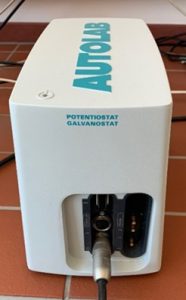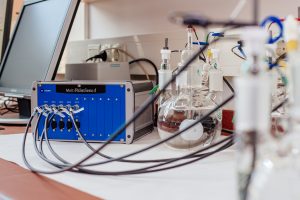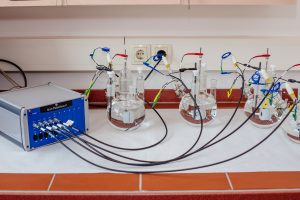Electrochemical research
- The development of modified electrodes for electrochemical determination
- Electrochemical impedance spectroscopy
- Cyclic voltammetry
- Stripping analysis
- Chronopotentiometry, polarisation resistance, potentiodynamic curve, and cyclic polarisation measurements
- The use of electrochemical techniques in corrosion studies.
Equipment
Potentiostat/galvanostat Autolab PGSTAT204 (Metrohm)
The Autolab PGSTAT204 is a potentiostat/galvanostat with a built-in FRA32M module, which enables electrochemical impedance spectroscopy measurements. The instrument can also be fitted with other modules for pH and temperature measurements, a dual mode bipotentiostat, an electrochemical quartz crystal microbalance, etc.
The Autolab PGSTAT204 can be used for most of the standard electrochemical techniques. The instrument allows the selection of eight current ranges from 10 nA to 100 mA and has a potential range of ±10 V. The FRA32M module enables the performance of both potentiostatic and galvanostatic impedance measurements over a wide frequency range from 10 µHz to 1 MHz.

Multi-channel Potentiostat/Galvanostat/Impedance Analyzer MultiPalmSens 4 (2 devices with 5-channels) (PalmSens)
The MultiPalmSens 4 is a multichannel potentionstat/galvanostat and impedance analyser that consists of five independent PalmSens4 potentiostats. All independent channels allow the selection of nine current ranges from 100 pA to 10 mA and have a potential range of ±10 V. The electrochemical impedance spectroscopy measurements, with a maximum frequency of 1 MHz, can be performed with each individual channel.
The MultiPalmSens 4 can also be used as a bipotentiostat. This means that it enables the simultaneous use of two working electrodes, one auxiliary electrode, and one reference electrode in a single electrochemical cell.
The MultiPalmSens 4 can be used for different voltametric, pulse, amperometric, and galvanostatic techniques. It additionally enables the performance of potentiostatic/galvanostatic impedance spectroscopy measurements.

